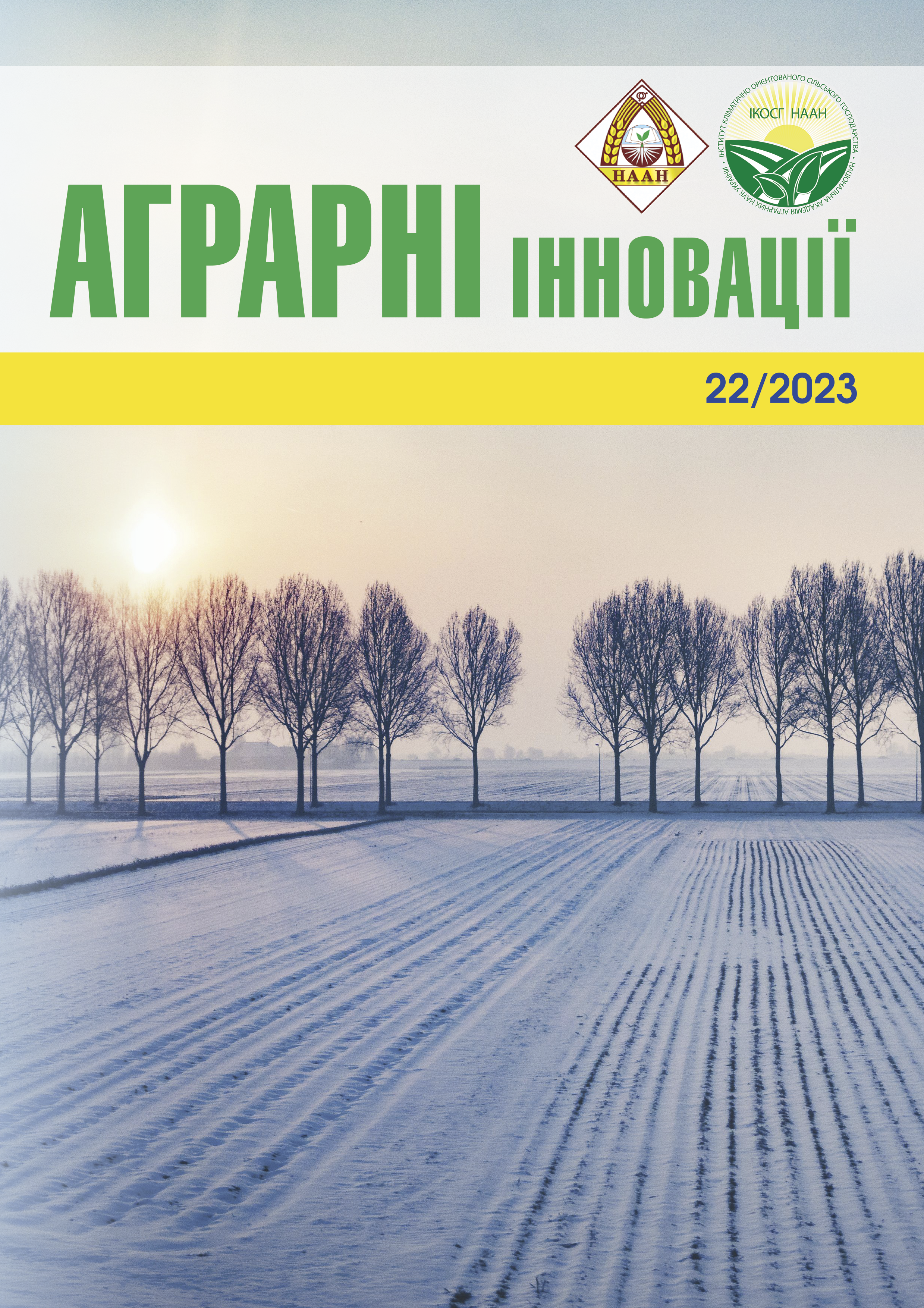ADAPTIVE TECHNOLOGIES IN SHAPING THE YIELD OF SEED MILLET DEPENDING ON BIOCLIMATIC CONDITIONS
Abstract
The aim is to investigate the influence of the bioclimatic conditions of the region on the process of formation of yield of seed millet (Panicum miliaceum L) when using biological fertilizers and multifunctional complex preparations. We studied the process of formation of millet yield, its growth and development during the growing season, and also worked on the development of adaptive technologies and methods for optimizing the growing process, taking into account the specific bioclimatic and ecological conditions of the region. The results. The level of productivity with the use of biological fertilizers and multifunctional complex preparations in foliar fertilization was higher than the control by 13.4%. It was also noted that the highest yield of millet is noted in the variant with an inter-row interval of 15 cm, which directly depended on the number of plants per 1 hectare. Thus, the yield of millet with an inter-row interval of 15 cm in the years of the study varied from 2.8-3.3 t/ha, which was almost two times higher than that of sowing with an interval of 30 cm. In the variant in which sowing was carried out at 30 cm intervals, the productivity was observed in the range from 2.2 to 2.3 t/ha. When applying, in the pre-sowing treatment of seeds, biofertilizers and multi-purpose complex preparations, the yield was higher on the variants of using the biostimulant Gumikor 2.6-2.9 t/ha, and when using Gumiam-01 the yield was 2.5-2.7 t/ha. In options for the use of biofertilizers and multifunctional preparations in foliar feeding, the best result was obtained with the use of the HELAFIT-Combi biostimulator 3.2-3.5 t/ha. Other options: biostimulator-rooting Gumikor yield 2.8-3.1 t/ha, organic preparation BIO-GEL 2.4-2.6 t/ha and biostimulator-adaptogen Gumiam-01 – 2.1-2.3 t/ha. In 2021, the amount of precipitation amounted to 525 mm, accordingly, the GTK indicator according to Selyaninov is 1.40, the whole year was characterized as sufficiently wet. However, annual fluctuations of the GTK index were noted in the range of 0.13 – 2.83, the yield of seed millet was 2.8 t/ha. In 2022, the total amount of precipitation was 276 mm, according to the GTK indicator, the year was characterized as an average-dry one with a value of 0.65, the annual fluctuations of GTK during the growing season were 0.13-2.12, and the yield was 2.5 t/ha. In 2023, the total amount of precipitation amounted to 416 mm, and according to the GTK indicator of 0.99, the year was characterized as weakly arid with fluctuations in the GTK indicator during the growing season of 0.16-3.23, the final yield of millet was 2.7 t/ha. Conclusions. Thus, the highest crop yield was recorded in 2021 – 4.4 t/ha using the HELAFITCombi biostimulator with a row width of 15 cm and pre-sowing seed treatment with the Gumikor biostimulator.
References
2. Калетнік, Г.М., Мазур, В.А., Браніцький, Ю.Ю., & Мазур, О.В. (2020). Оптимізація технологічних прийомів вирощування проса лозовидного (світчграс) для умов Лісостепу Правобережного: монографія. Вінниця: ВНАУ. 212 с.
3. Каленська, С.М., & Черній, В.П. (2016). Передумови органічного вирощування проса. Органічне виробництво і продовольча безпека: зб. матеріалів доп. учасн. IV Міжнар. наук.-практ. конф. Житомир: О.О. Євенок. С. 286–291.
4. Ковальов, М.М., Резніченко В.П. (2020). Оцінка якісних показників підземних вод для систем ін’єкційного мікрозрошення за вирощування томату розсадним способом. Таврійський науковий вісник. Вип 115. Херсон. ХДАЕУ. С. 76-84.
5. Шевченко, О.А., & Сидякіна, О.В. (2023). Впровадження інноваційних технологій в селекції та насінництві сільськогосподарських культур як аспект економічного розвитку України. Генетика та селекція сільськогосподарських культур – від молекули до сорту: матеріали VІ інтернет-конференції молодих учених м. Київ. С. 32–33.
6. Писаренко, В.М., Писаренко, П.В., & Писаренко, В.В. (2019). Напрями адаптування землеробства до змін клімату. Матеріали міжнародної науково-практичної конференції: Кліматичні зміни та сільське господарство. Виклики для аграрної науки та освіти. ДУ НМЦ «Агроосвіта». C. 9-22.
7. Васильковська, К., Андрієнко, О., & Шепілова, Т. (2023). Ефективність агродронів в системі точного землеробства. Аграрні інновації, (17). Вид. дім «Гельветика». С. 13-18
8. Пономаренко, І.О., Тарасов, В.А., Ігнатченко, А.С., Игнатченко, А.С., Химченко, Ю.В., & Ковальов, Б.Л. (2021). Економічна ефективність використання дронів у сільському господарстві. Вісник СумДУ (4). C. 235-240
9. Гапон, В. (2023). Особливості впровадження цифрових технологій в сільському господарстві. Матеріали ХІ Міжнародної науково-практичної конференції Формування механізму зміцнення конкурентних позицій національних економічних систем у глобальному, регіональному та локальному вимірах. C. 32-33.
10. Добряк, Д.С. (2016). Науково-методичні погляди до інтенсифікації використання земельних ресурсів сільськогосподарських підприємств. Вісник ХНАУ. (1), 64-69.
11. Скиба, В., Туряк, К. (2023). Динаміка врожайності основних сільськогосподарських культур та перерозподілу посівних площ під їх вирощування в умовах адаптивності до зміни клімату. Збірник матеріалів VІ Міжнародної науково-практичної конференції. НМЦ ВФПО. Київ. С. 4-8.






